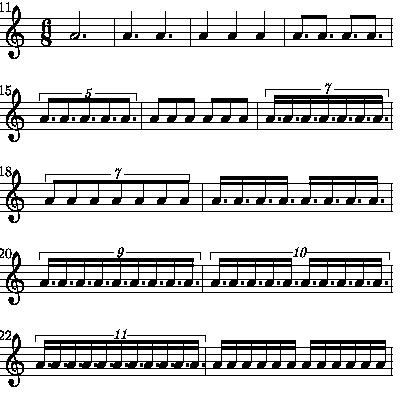Here are some notation rules and durational information about tuplets.
One of the problems with tuplets is the duration of the notes which make them up. The following example demonstrate the values of the notes in both simple and compound time signatures.


As the example shows the durations of the notes are different for the two types of time signature. But the durations are multiplied by the same factor in their own time signature.


The source for the examples shows that the durations of the notes are multiplied as follows for the two types of time signature.
| Time Sig Type | Tuplet Type | Multiplication Factor | Note Value to use for the first example |
|---|---|---|---|
| Simple | Triplet | 2/3 | crotchet |
| Simple | Quintuplet | 4/5 | quaver |
| Simple | sextuplets | 4/6 | quaver |
| Simple | septuplets | 4/7 | quaver |
| Simple | 9th Tuplets | 8/9 | semiquaver |
| Simple | 10th Tuplets | 8/10 | semiquaver |
| Compound | Quintuplets | 4/5 | dotted quaver |
| Compound | Septuplets | 8/7 | dotted semiquaver |
| Compound | Septuplets | 6/7* | quaver |
| Compound | 9th tuplets | 8/9 | dotted semiquaver |
| Compound | 10th Tuplets | 8/10 | dotted semiquaver |
| Compound | 11th Tuplets | 8/11 | dotted semiquaver |
* Alternate Notation
It is common to use the note-values of a regular note-division for the tuplets until the next shorter note value is reached. This means that when the beat is separated into various equal divisions as shown in Fig 1. The note value used is the one closest to the number of division that you want. For example, if you wanted triplets to cover a 2 beat(minims) note in 4/4 you would use 1 beat notes(crotchets). This is also shown in the examples.
There are alternatives for septuplets in simple time and quintuplets and octuplets in compound time. These can be notated using the next shortest note value as some people deem them to be closer to that duration.
Any rhythm can be placed inside a tuplet as long as the total durations of the notes involved do not exceed the total duration allowed for the tuplet.

For more information see the input/test directory on the Lilypond source code